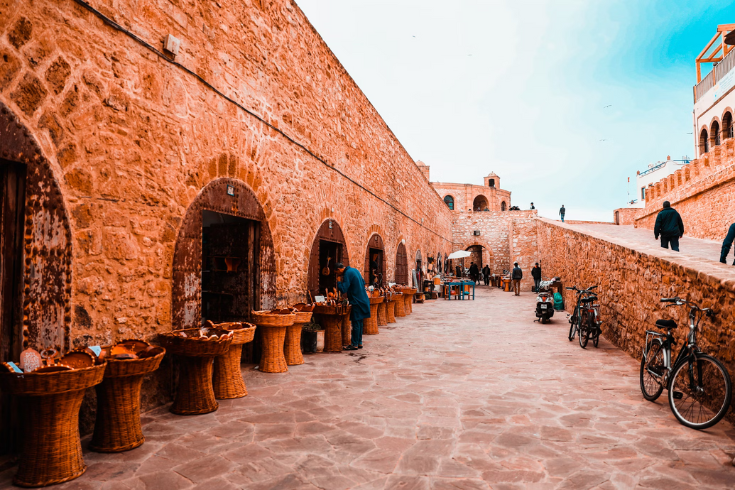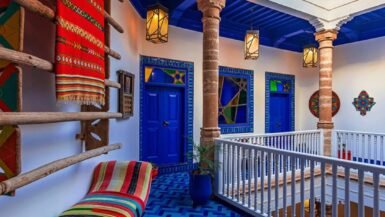Essaouira is known for its coastal charm and distinctive tranquility, but it’s also a city with a rich history manifested in the historical monuments scattered between its ramparts, port, and beaches. This enchanting city, formerly known as “Mogador,” carries within it stories from the past and diverse heritage that deserves exploration, as is the case in other Moroccan cities such as Tangier and Marrakech.
In this guide, we will take you on a tour to explore the most remarkable tourist places in Essaouira, from its beating heart the medina (Kasbah) and its ramparts, to the vibrant Essaouira port, passing through its diverse religious heritage that includes mosques, a synagogue, and a mausoleum, not forgetting the beauty of the coast and beaches that are an integral part of the identity of this wonderful Moroccan city.
The Medina and Its Ramparts in Essaouira: Heart of the City and UNESCO Heritage
The medina of Essaouira, classified by UNESCO as a World Heritage site, is the historical heart of the city and home to its main monuments and defensive city ramparts that reflect the authenticity of Moroccan history and architecture.
The Medina (Kasbah): Strolling Through Charming Alleys
The Kasbah of Essaouira is distinguished by its peaceful atmosphere compared to other medinas like Fez and Marrakech, where buildings painted in white and blue spread, giving the place a unique maritime character. The narrow, winding alleys house art galleries and city souks that display traditional products of Essaouira, especially those made from the famous thuya wood and also products from the local argan forest.
City Ramparts: Defense and Panoramic Views
The city ramparts of Essaouira are among the most remarkable historical monuments, built mainly in the 18th century during the Alaouite era, with clear European influences. These ramparts were designed to protect the city from maritime invasions and almost completely surround the medina, making them a witness to the military engineering expertise of that time. Visitors can walk on parts of these ramparts and enjoy breathtaking panoramic views of the Atlantic Ocean and the city.
Pasha Tower (Skala of the Kasbah) and Port Skala
The Pasha Tower, also known as “City Skala”, is one of the most famous historical monuments of Essaouira. It’s a fortified platform located within the medina, equipped with old cannons directed toward the sea and Mogador Island. This tower offers magnificent views that make it a major tourist attraction in the city. As for the “Port Skala,” it’s located near the port and offers different views that are equally splendid.
Essaouira Port: Living Maritime History
Essaouira port is more than just a fishing port; it’s a witness to the city’s commercial and maritime history, and it continues to pulse with life and activity, making it one of the most important historical monuments in the city and a center for enjoying fresh Essaouira cuisine.
Essaouira Port Atmosphere: Blue Boats, Fishermen, and Seagulls
Essaouira port is distinguished by its characteristic blue boats lined up in a unique visual spectacle, and the daily activity of fishermen that begins from the first hours of dawn. The lively fish market is one of the most vibrant places, where you can observe different types of fresh fish displayed for sale and enjoy the experience of fresh Essaouira cuisine directly from the sea. For more information about Morocco’s ports, you can visit the National Ports Agency.
Historical Role of the Port
Essaouira port played an important historical role in the 18th and 19th centuries, serving as a main commercial port connecting Morocco to Europe and the rest of the world. It was founded by Sultan Sidi Mohammed ben Abdellah as part of his vision to develop the city and strengthen Moroccan maritime trade.
Diverse Religious Heritage in Essaouira: Testimony of Historical Coexistence
Essaouira is distinguished by a long history of coexistence between different religions, which is reflected in its religious monuments that include mosques, a synagogue, and a mausoleum, as well as Christian monuments, forming an important part of Essaouira’s historical monuments.
The Grand Mosque and Zaouia Sidi Mimoun (Islamic Heritage)
The Grand Mosque is one of the most remarkable Islamic monuments in Essaouira’s medina, and constitutes an important religious center for local residents. As for Zaouia Sidi Mimoun, it’s a Sufi site that enjoys great respect. It should be noted that these sites are usually reserved for Muslims only, but non-Muslim visitors can admire their architecture from the outside.
Jewish Heritage: The Mellah, Synagogue, and Mausoleum
Essaouira Mellah (historical Jewish quarter) constitutes an important part of the city’s history, where a large proportion of the Jewish population resided in the past. Simon Synagogue is located within the Mellah, it’s a remarkable historical monument that has been restored and can be visited as a museum and historical site. As for the Rabbi Haim Pinto mausoleum, it’s located outside the medina walls and is considered an important pilgrimage site. For more information about Jewish heritage in Morocco, you can visit the Moroccan Jewish Heritage Foundation.
Christian Monuments
Although few in number, Christian monuments in Essaouira testify to the historical presence of Christian communities, especially during the Portuguese influence period. These monuments include the remains of the Portuguese church and historical buildings and cemeteries that are marks of this history.
Other Historical and Cultural Buildings
Besides religious monuments and fortifications, Essaouira also houses other historical buildings of cultural importance that are added to the list of Essaouira’s historical monuments.
Dar Souiri
Dar Souiri is one of the beautiful historical buildings in the city, which has now transformed into a cultural center hosting events, exhibitions, and Dar Souiri and art galleries and Gnawa music performances, especially during the famous annual Gnawa festival. It’s distinguished by its magnificent traditional architecture and constitutes a living example of historical houses in Essaouira.
Coast and Beaches in Essaouira: Nature, Winds, and History
The coast and beaches are an integral part of Essaouira’s identity and tourist attraction, offering a different experience from exploring historical monuments within the walls.
Coastal Beauty and Beach Activities
Essaouira beach extends southward with its long sandy beaches, famous for strong winds that make it an ideal destination for surfing and kitesurfing, earning it the nickname “city of winds.” The unique atmosphere on the beach with seabirds and vast open spaces, plus the possibility of camel or horse riding, make visiting the coast an unforgettable experience. For more information about beach tourism in Morocco, you can visit the Moroccan National Tourism Office.
Historical Views from the Coast
From the beach, visitors can enjoy magnificent views of the city ramparts and historical islands near the beach (including remains of the old Portuguese fort on Mogador Island). This angle offers a unique opportunity to see Essaouira’s historical monuments from a different perspective.
Visiting Essaouira’s Historical Monuments: Practical Guide and Important Tips
To explore Essaouira’s historical monuments and enjoy their beauty, here are some practical tips for getting around and exploring, with the best accommodation options in Essaouira.
Getting Around Essaouira
Essaouira’s medina is relatively small, and walking is the best way to see most sites. Small taxis can be used to reach external sites like Rabbi Haim Pinto’s mausoleum or to access more distant parts of the beach.
Opening Hours and Entrance Fees
You can stroll through the medina alleys, ramparts (Skala), port, and beaches for free and access them during most daylight hours. However, some sites like Dar Souiri or Simon Synagogue may have specific opening hours and entrance fees.
Visiting Rules and Behavior
It’s advisable to wear modest clothing when visiting or passing near religious sites (mosques, synagogue, zaouias, mausoleums). Also pay attention to prayer times near mosques. It’s preferable to ask permission before photographing people, especially in the port or local areas.
The best time to visit Essaouira is spring and autumn when the weather is pleasant, knowing that winds can be strong year-round. Summer is popular but usually windy. Regarding time of day, the port is active in the morning and late evening, while watching the sunset from the Skalas is an unforgettable experience.
Conclusion: Essaouira… City of History, Spirituality, and Beauty on the Coast
Essaouira’s historical monuments are distinguished by their diversity and unique charm, from the fortified medina and its ramparts to Essaouira port, through its diverse religious heritage and the beauty of the coast and beaches. Each of these sites contributes to building the unique character of this charming coastal city, which offers a different experience from other Moroccan cities like northern Tangier or inland Marrakech.
Exploring these historical monuments offers visitors an opportunity for deep connection with Essaouira’s multi-layered history and its vibrant present. We encourage you to use this guide to plan your visit to explore Essaouira’s historical monuments, share the article, and share your own experiences or favorite sites with others.
For more information about tourism in Morocco and planning your trip, you can visit the Moroccan Ministry of Tourism or Morocco Tourism Guide.
Have you ever visited Essaouira? What is your favorite historical monument in this charming city? Share your experiences in the comments!






Leave a reply